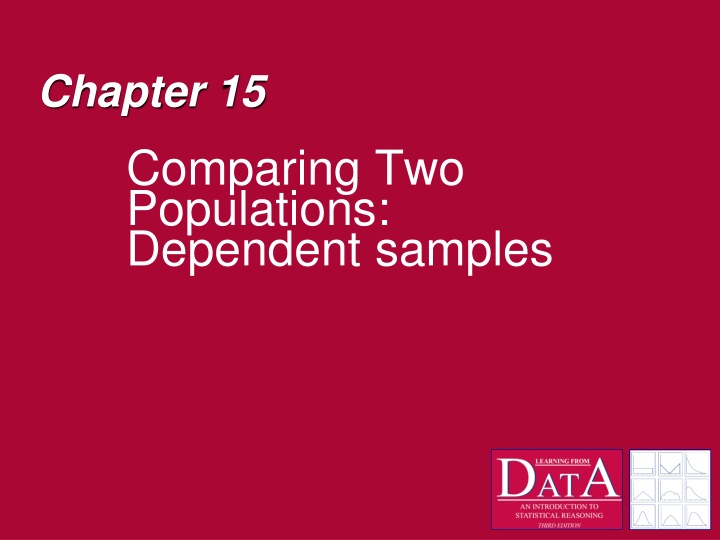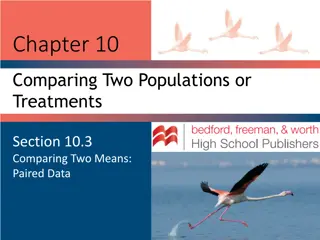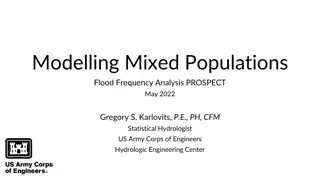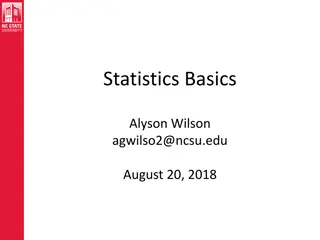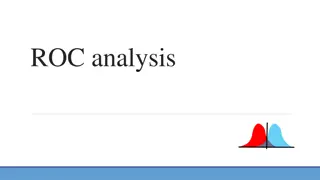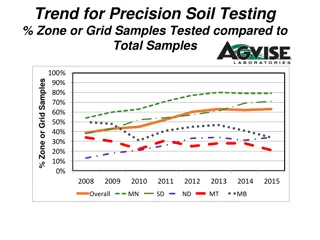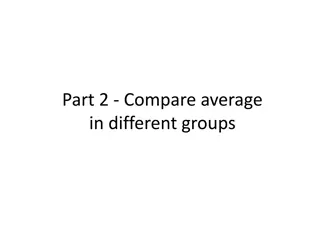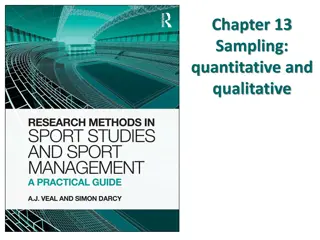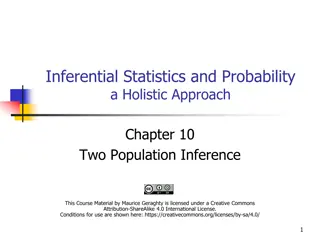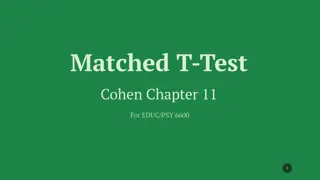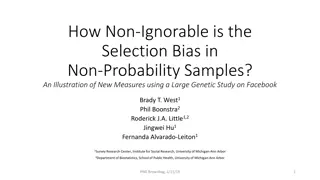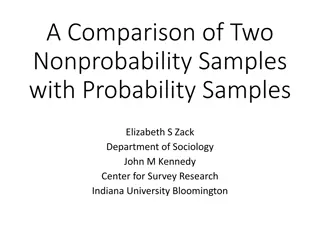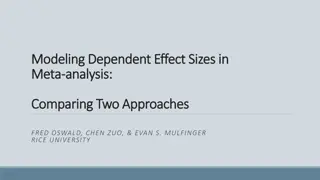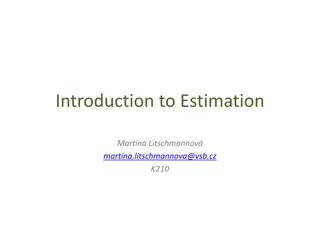Comparing Two Populations Using Dependent Samples
Comparison of two populations using dependent samples involves related measurements from the same subject or matched pairs. Advantages include requiring fewer subjects and increased power due to decreased variability, but carry-over effects may be a disadvantage. Strategies to address carry-over effects in research designs are discussed, such as using matched-pairs designs to eliminate the issue. The dependent samples t-test is explained, which involves calculating the mean difference, standard error, and t-value to compare paired scores.
Download Presentation

Please find below an Image/Link to download the presentation.
The content on the website is provided AS IS for your information and personal use only. It may not be sold, licensed, or shared on other websites without obtaining consent from the author.If you encounter any issues during the download, it is possible that the publisher has removed the file from their server.
You are allowed to download the files provided on this website for personal or commercial use, subject to the condition that they are used lawfully. All files are the property of their respective owners.
The content on the website is provided AS IS for your information and personal use only. It may not be sold, licensed, or shared on other websites without obtaining consent from the author.
E N D
Presentation Transcript
Chapter 15 Comparing Two Populations: Dependent samples
Dependent Samples Dependent Samples - measurements are somehow related to one another either because: The measurements came from the same subject (Within-subjects design), or Subjects were paired or matched (Matched-pairs design) May also be called a Repeated- measures designs
Why use dependent samples? Advantages Fewer subjects required with a within- subjects design (each subject is measured twice) Increased power through decreased variability Disadvantages Carry-over effects
Carry-over Effects Let s say we are interested in methods to teach reading to pre-schoolers We introduce the whole-language method, measure, then use the phonics method, and measure We have a repeated-measures (within- subjects design), but
Carry-over Effects How can we remove the effects of teaching reading with the whole- language method? There is a carry-over to the next condition (phonics) condition, because the preschoolers may have learned to read Do we expect to forget how to read once they learn to?
Carry-over Effects Matched-pairs designs will eliminate the carry-over effect problem Matching, though, must be done well, without respect to the obtained scores, matching is done before the experiment Along a dimension that is relevant to the study
Dependent Samples t-test With pairs of scores, either the result of matching or taking multiple measurements from the same subject Calculate the difference (D) between the two scores (maintaining positive and negative values) Calculate the mean difference, standard error, and then t
Dependent Samples t-test t =MD- D0 sMD where sD np sMD=
Dependent Samples t-test MDis the mean of the differences sDis the standard deviation of the differences sMDis the estimated standard error of the sampling distribution of MD 0is the difference between the population means (parameter)
Example of a Dependent Samples t-test We want to compare a new teaching method with a traditional method on math 2 groups - 10 12thgrades in each, Group Old receives old method, Group New gets new method Subjects are matched on their IQ
Hypothesis test of Old vs. New (teaching math) 1. State and Check Assumptions About the population Normally distributed? - don t know Homogeneity of variance we ll check About the sample Independent Random sample? yes Dependent samples About the sample Interval level
Hypothesis test of Old vs. New (teaching math) 2. Hypotheses HO: Old= New (the effectiveness of the old and new method are the same) Old- New= 0 (the difference between the effectiveness of Old and New is 0) HA: 1 2 (the effectiveness of Old and New are not equal) 1- 2 0 (there is a difference between the effectiveness the Old and New)
Hypothesis test of Old vs. New (teaching math) 3. Choose test statistic 2 groups dependent samples Dependent-sample t-test
Hypothesis test of Old vs. New (teaching math) 4. Set Significance Level = .05 Critical Value Non-directional Hypothesis with df = np- 1 = 10 - 1 = 9 From Table C, critical value of /2 = .025 tcrit= 2.262, so we reject HOif t - 2.262 or t 2.262
Hypothesis test of Old vs. New (teaching math) 5. Compute Statistic We need: D2 2 np, D, ,MD,sD df ,sMD
Scores on the WAT (Wisconsin Achievement test) Old New D Need: MD sD sMD 78 55 95 57 60 80 50 83 90 70 74 45 88 65 64 75 41 68 80 64 4 10 7 -8 -4 5 9 15 10 6
Scores on the WAT Old New 74 45 88 65 64 75 41 68 80 64 D 78 55 95 57 60 80 50 83 90 70 4 10 7 -8 -4 5 9 15 10 6 D = 54 D2= 712 MD= 5.4 SS(D) = 420.4 s2D= 46.7111 sD= 6.833 np= 10 sMD= sD/ np = 6.833/ 10 = 2.161
Example t =MD- D0 (non- directional HA) t is greater than tcrit, reject HO sMD t =5.4 -0 2.161 df = np-1=10-1= 9 tcrit(9)= 2.262 = 2.499
Hypothesis test of Old vs. New (teaching math) 6. Draw Conclusions because our t falls within the rejection region, we reject the HO, and conclude that the old and new method differ in their effectiveness in teaching math, with the old method superior
Comparing Dependent and Independent Samples t-tests Suppose, instead of pairing subjects based on IQ, we compared the mean of the two groups using a 2- independent samples t-test t =M1- M2 sM1-M2
Scores on the WAT Old 78 55 95 57 2219.6 60 80 50 83 90 70 New 74 45 88 65 1902.4 64 75 41 68 80 64 XO= 718 X2O= 53772 MO= 71.8 SS(XO) = XN= 664 X2N= 45992 MN= 66.4 SS(XN) = s2O= 246.622 sO= 15.70 nO= 10 s2N= 211.377 sN= 14.54 nN= 10
Independent Samples t-test = SS(XO)+SS(XN) df 1 nO +1 1 nO +1 sMO-MN= 2 sp nN nN (2219.6 +1902.4) 18 10+1 1 sMO-MN= 10 sMO-MN= 6.77 t =MO- MN sMO-MN =71.8-66.4 6.77 = 0.7978 Cannot reject HO
Comparison (cont.) By matching subjects, a priori (prior to the experiment) the variance is reduced substantially, thereby Allowing us to find a difference that was obscured
Ranking When completing a Wilcoxon, ranking must be done with the smallest difference receiving the lowest rank (1) The biggest difference gets a rank of np
Hypothesis Test with non- parametric alternative to t-test Nicotine patches supposedly reduces smoking A psychologist records the number of cigarettes each of 9 patients smokes per day without a patch and with a nicotine patch.
Hypothesis Test 1. State and Check assumptions Random Sample - yes Dependent Sample (Within-subjects design) measures come from the same person (wearing the patch, and not wearing the patch) Number of cigarettes smokes normally distributed? - not sure Homogeneity of Variance - nope
Hypothesis Test 2. State Hypotheses HO : BEFORE = AFTER HA : BEFORE > AFTER
Hypothesis Test 3. Choose Test 2 dependent samples H of V - no Wilcoxon Tm (Wilcoxon signed-ranks test)
Hypothesis Test 4. Set Significance level = .05 with np > 8, the Wilcoxon Tm approaches a z directional alternative at .05, using Table A z = 1.65 if obtained z 1.65, Reject HO
Hypothesis Test 5. Compute Test Statistic + = T positiveRanks + T + = z T + T + ( 1) n n p p = + 4 ( T + + 1)(2 24 1) n n n p p p = + T
Wilcoxon Test Non-parametric alternative to dependent sample t-test Calculate the differences between paired scores (D) Calculate the absolute value of each (|D|) Rank |D| Sign the ranks using the sign from D Add all positive Ranks (T+)
Hypothesis Test 6. Draw conclusions Since the obtained z was greater that the critical z of +1.65, HOis rejected, and Conclude that the distributions are different with the before values greater than the after values
Review Procedure for calculating t Independent samples Compute (for each group): , M M 1 , , 2 2 1 2 2 s s n n SS X 1 2 ( ), ( ) SS X 1 2
Calculating t - Independent Samples To find t, the estimated standard error of the sampling distribution is calculated: + 1 n 1 n = + 2 p s s M M 1 2 1 2 ( ) ( 2 ) SS X SS X = 2 p 1 2 s + n n 1 2
Computing t The t statistic ( a family of distributions which varies with df) is computed using: M M = 1 2 t s M M 1 2
Review Procedure for finding t Dependent Samples matched-pairs, correlated samples, repeated-measures, etc. (2 samples) Compute D (the difference between pairs of scores) np (the number of pairs of scores MD (the mean of the differences)
Dependent Samples t (cont.) Compute sD (the standard deviation of the differences) sMD (the estimated standard error)
Estimated Standard Error and t sD np sMD= t =MD- D0 sMD
Conceptually, what is the t statistic? In both tests, the numerator is a measure of the observed difference between scores (either unpaired or paired) The denominator, of both tests, is an estimate of the standard deviation of the sampling distribution of M1 - M2 (we call it standard error )
Error Terms When a sample is taken from a population, statistics computed from the sample are estimates of parameters, however, A certain amount of variability is expected (no two sample means are exactly alike) This variability from sample to sample is called error
Error and t-tests The amount of error obtained from a sample is used to estimate the standard error that might be expected in the situation (given n, etc.) This error can produce large (significant) differences between sample statistics, just by chance, because no two sample means are exactly alike
t statistic as a ratio Therefore, obtained difference t = difference expected by chance ( error ) We will return to this type of conception again
Can t tell the difference between independent and dependent samples? If measurements are related to one another - dependent samples You will not be told when to use independent or dependent samples t- tests You have to decide
Example A psychologist believes that environment is more important than genetics in influencing intelligence. She locates 12 pairs of identical twins that have been reared apart, one twin in each pair in an enriched environment and the other in an impoverished one. Independent or Dependent Samples?
Another A new experimental drug, ABZ, is thought to have beneficial effects on AIDS. 20 AIDS patients are randomly selected and assigned to one of two conditions: ABZ for 90 days or Placebo for 90 days. Independent or Dependent Samples?
A third example A researcher suspects that increasing the level of lighting during the winter months will increase mood. The researcher selects 36 students, tests their mood, then replaces the light bulbs in the dorm from 75-W to 100-W for 1 month, then tests each student again Independent or Dependent Sample?
